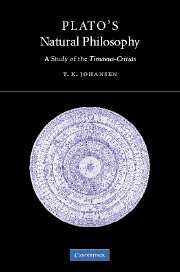Book contents
- Frontmatter
- Contents
- Acknowledgements
- Introduction: Plato's tales of teleology
- 1 What is the Timaeus-Critias about?
- 2 The status of the Atlantis story
- 3 The status of Timaeus' account
- 4 Teleology and craftsmanship
- 5 Necessity and teleology
- 6 Space and motion
- 7 Body, soul, and tripartition
- 8 Perception and cosmology
- 9 Dialogue and dialectic
- Epilogue
- Bibliography
- General index
- Index locorum
9 - Dialogue and dialectic
Published online by Cambridge University Press: 03 September 2009
- Frontmatter
- Contents
- Acknowledgements
- Introduction: Plato's tales of teleology
- 1 What is the Timaeus-Critias about?
- 2 The status of the Atlantis story
- 3 The status of Timaeus' account
- 4 Teleology and craftsmanship
- 5 Necessity and teleology
- 6 Space and motion
- 7 Body, soul, and tripartition
- 8 Perception and cosmology
- 9 Dialogue and dialectic
- Epilogue
- Bibliography
- General index
- Index locorum
Summary
The Timaeus-Critias, like Plato's other works, is commonly referred to as a dialogue. Yet from 29d6 to the end, that is to say for about five-sixths of the text, the Timaeus takes the form of a monologue, and roughly the same holds for the Critias. There are other Platonic dialogues which contain long, uninterrupted speeches, for example, the Apology and the Laws. Yet there is, with the possible exception of the Menexenus, no other work that to such an extent is dominated by monologue. What has happened to the dialogue form in the Timaeus-Critias? In what sense, if any, can we call this work a ‘dialogue’? And if Plato has given up on the dialogue form in the Timaeus-Critias, how does this reflect on the sorts of inquiry that Timaeus and Critias are engaged in? We tend to think of Plato's method of philosophy as dialectical, at least in the minimal sense of involving questions and answers. Has Plato then changed his conception of philosophy in this work, and if so, why in this work?
DIALOGUE
One can talk about at least four kinds of dialogue in Plato, and no doubt there are more. There is the dialogue between the characters within the works. So, for example, Socrates discusses the immortality of the soul with Simmias and Cebes in the Phaedo. There is also the dialogue between the narrator of such conversations and his audience.
- Type
- Chapter
- Information
- Plato's Natural PhilosophyA Study of the Timaeus-Critias, pp. 177 - 197Publisher: Cambridge University PressPrint publication year: 2004



